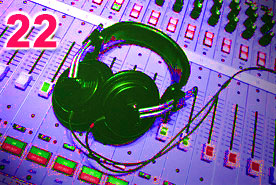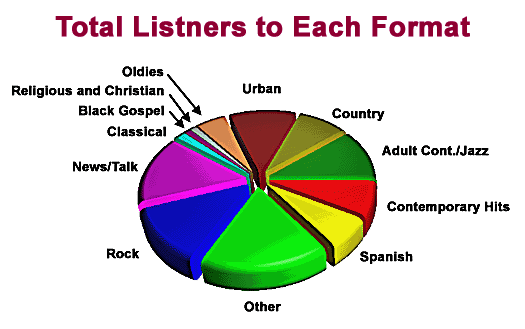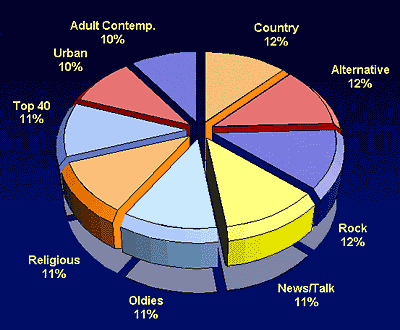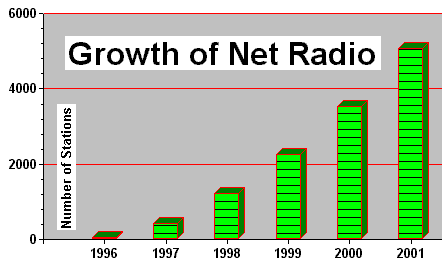|
Film, Radio and TV - 22b |
|
Radio Part II
Approaches to Radio Formats Although appealing to audience segments by programming specific formats may have worked well in midsize markets, in the larger cities there were more radio stations than music formats. The question then became how to make your station--regardless of its format--stand out from the rest. First, station program managers looked for ways of developing unique music and personality mixes. (Their jobs, like those of football coaches, depend on a winning season. In this case this means high station ratings.) To further specialize, the major formats were subdivided; "rock" became "soft rock," "hard rock," "contemporary hits," etc. Tapping into the power of nostalgia and associations with past memories, some stations specialized in hits of the 50s, or hits from the 70s, or the 80s. Some stations boasted of having a "perfect mix" of various kinds of music. The chart below lists the most popular formats that have developed. The larger the slice of the "pie," the more listeners.
You will note that this graph differs in some ways from the listening patterns reported by car radio listeners (below). This is particularly evident when it comes to religious radio stations. These stations--particularly the evangelical stations--have been steadily growing in number in the U.S., especially after some FCC content requirements were relaxed on frequencies reserved for "educational" stations. Interestingly, there are some big differences between the popularity of specific formats (as shown above) and the number of stations in the United States that use these formats. This is particularly evident when it comes to country music. There are more radio stations in the United States specializing in country music than any other format. Most are in rural areas. On the other hand, there Note that in the graph on the right that, despite this disparity, country and news/talk have similar audiences--at least when it comes to audiences that listen on their car radios. Since the largest share of the overall radio audience today listens to news/talk stations (see previous graph), we'll conclude this module with information on this format. Most major radio markets have local talk shows. Only a few are broadcast nationally. Almost all of these are conservative, highly opinionated and popular--primarily with white, male audiences. Leading the list is Rush Limbaugh. Limbaugh came from a conservative Republican family, started as a radio announcer at an early age, and eventually worked his way to New York City. In 2003, Limbaugh's show was being heard on almost 600 radio stations, and he was the highest paid radio talk show host in the U.S. Limbaugh often uses humor to charm audiences and get his points across. By making fun of or mocking women's liberation, gays, environmentalists, and the former President Clinton and his family, he won over millions of faithful followers. Although Limbaugh isn't considered an example of "hate radio," many talk show hosts who regularly deride Jews, blacks, Hispanics, and almost any group that isn't "American, have clearly moved in this direction. Possibly not entirely unrelated, according to a 2001 FBI report, hate murders (on the basis of race, religion, ethnicity, sexual orientation, or disability) have reached a five-year high in the United States. Although most talk radio personalities are conservative, there are two well-known radio personalities that might be considered on the other side of the ledger: Don Imus, and Howard Stern. "Shock jock" Howard Stern is the more impertinent of the two. His irreverent abandon during his syndicated morning talk show manages to fascinate and stir listeners--as well as stir the retribution of the FCC, which has fined him (or, more specifically, the stations that carry his programs) more than $1-million over the past few years. However, since the revenue his show generates far exceeds the fines levied against him, there seems to be little motivation to tone down his antics.
We've noted that both film and radio now attract audiences by constantly pushing the envelope of what society sees as acceptable. There is no doubt that some of society's anachronistic views are in need of modernizing. The questions arises as to what extent we can deride large segments of our population, along with our elected leadership, and mock or abandon our cultural values, without undermining our social order.
In the last few years we've seen the emergence of a new radio medium: the Internet. Today, more than 5,000 traditional (terrestrial) radio stations also broadcast their signals over the Internet. The graph below shows the rapid growth of "net radio."
You can see from the graph above that the number of worldwide terrestrial radio stations that broadcast on the Internet has undergone explosive growth in the past five years. Many listeners are people displaced from their hometowns who want to keep up with events "back home." (Most on-air radio stations can only reliably broadcast over a 50 to 100 mile area, and net radio is worldwide.) In addition, there are tens of thousands of Internet-only radio stations. Since there are no laws governing Internet radio, anyone with a computer, the right hardware, software, and know-how can start an Internet radio station. Some of the links to net radio stations are: In November 2001, a new digital service was launched in the United States that offers more than 100 programming choices and doesn't suffer from some of the reception problems of terrestrial AM and FM radio stations. At the same time, heavy rain, thick trees with high moisture content, tunnels, etc., can momentarily block the satellite signal. The first fee-based service to transmit digital signals from a satellite was called XM Radio. In the first two months of operation XM Radio signed up more than 25,000 subscribers. A similar service from Sirius Satellite Radio began in 2002. In 2004, the latter also became a part of the DISH TV music channels. Unfortunately, the two services are not compatible, although both types of radios will receive standard AM and FM signals. Two major U.S. auto manufacturers include factory-installed satellite radios in some of their new models. "Off-the shelf" satellite radios now start at about $300, although this price will undoubtedly go down with increased demand and competition. In addition to far fewer (or no) commercials (depending on the service), the new services offer a much wider choice of digital-quality programming. Many people feel that the decline in radio listening in the United States in recent years is due in part to "commercial clutter." Many AM and FM radio stations now devote almost one-third of their broadcast time to commercials. Depending on the supplier, the monthly fee for the new satellite radio services ranges from $10 to $15. In addition to a wide variety of music and original programming, the new services include familiar programs from radio networks and programming services. The nation's 12,000 AM and FM stations have not only taken notice, but through the National Association of Broadcasters (NAB) they have launched various efforts to protect their turf by "controlling" the development of satellite radio. It's much too early to predict the impact of satellite radio. However, it's being assumed that drivers who spend more than 30 minutes a day commuting to and from work will be willing to pay for a much wider range of music and programming, and relief from the commercial clutter of standard AM and FM stations.
Like most of the mass media, a large percentage of U.S. radio stations are owned by media conglomerates. For example, Clear Channel Communications now owns 1,225 radio stations in 50 states. The Los Angeles area has at least 14 radio stations controlled by this one company. Other media conglomerates own large numbers of radio stations, but not as many as CCC. The whole CCC enterprise is run by one man: Texas billionaire L. Lowry Mays (whose profits went from $74 million to about $8 billion--a 100-fold increase--in ten years.) When a few media companies get too much power, allegations of unfair or biased content control often emerge. For example, according to The Los Angeles Times, (Feb. 25, 2002) Britney Spears alleges that CCC stations have refused to play her records because her company didn't hire CCC as their tour promoter. When more than 1,000 stations refuse to play an artist's records it represents a major blow to their success. We'll detail some of the major disadvantages of conglomerate control of the media in an upcoming module. In the next module we'll introduce the medium that caused so many problems for film and radio: television. |


 are a limited number of news/talk stations; but, since they are in urban areas, they have many more listeners.
are a limited number of news/talk stations; but, since they are in urban areas, they have many more listeners.